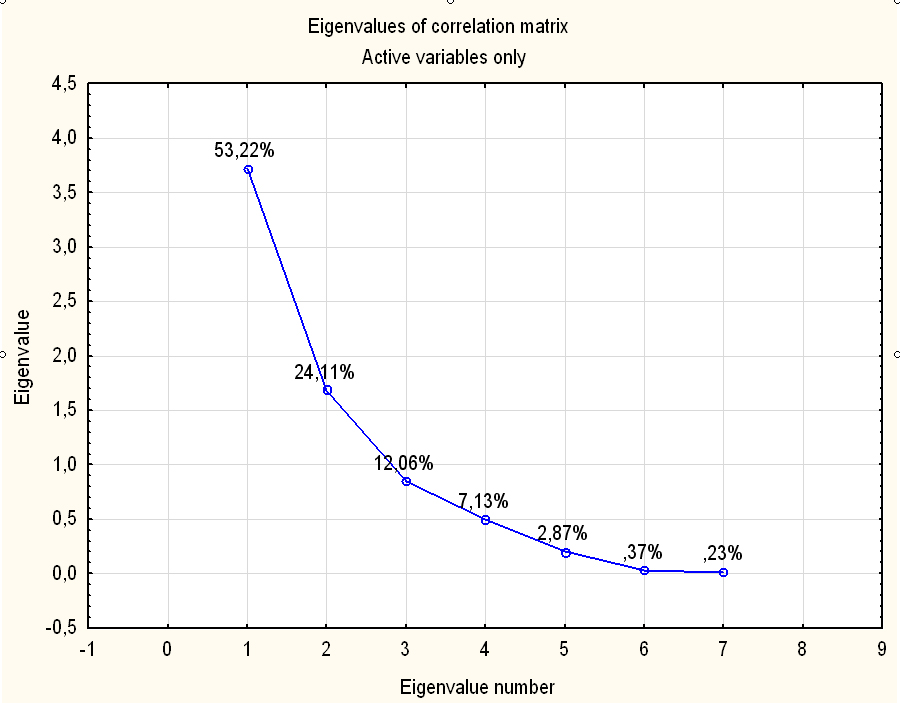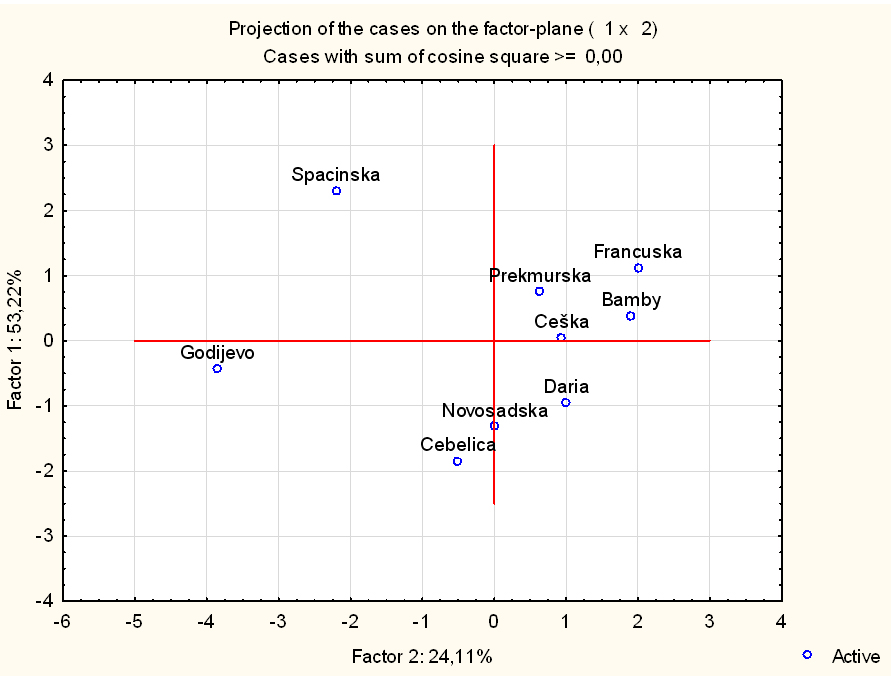ABSTRACT
Abstract
Principal component analysis (PCA) was used to investigate the classification of mineral component of nine different cultivars of buckwheat grain. This research showed that copper (-0.92) and iron (-0.90) contributed mostly to the first principal component whereas calcium (-0.86) to the second one. The total variability explained by the first component was around 53.2%, while by the second component it was 24.1%, which means that those two dimensions together accounted for around 77.3% of total variability of the observed set of variables. Principal component analysis (PCA) of the data set was able to distinguish different minerals and cultivars as well.
INTRODUCTION
Buckwheat (Fagopyrum esculentum Moench) originates from the middle Asia and was transferred by nomadic people to Central and Eastern Europe. Today, buck-wheat celebrates a come-back due to glu-ten-free diet. Less demands to soil, as well possibillity to double-cropping due to shot growing season (90-110 days), make buckweat very perspective culture (Au-brecht,1998). Group of pseudocereals pri-mary includes amaranth (Amarantha-ceae), buckwheat (Polygonacea) and qui-noa (Chenopodiaceae). Pseudocereals consider plant species that can not be bo-tanicaly classified into grass family, but re-garding their nutrition values and po-ssibilities to produce starch-rich grains they are very close to cereals (Kuhn, 1998, Bodroža-Solarov 2005).
Only few limited attempts had been made for genetic improvement of buckwheat grain which released variety of cultivars with high yield potential and better quality. Knowledge of genetic diversity among existing cultivars of any crop is essential for long term success of breeding program and maximizes the exploitation of the germplasm resources (Debnath et al., 2008). Genetic material, collected in Ser-bia and applied in this research, was exa-mined on morphological features with an overall development plan of breeding pro-gram (Nikolić et al., 2010).Testing of con-tent of minerals in grain is one of the im-portant components in selection and deve-lopment of breeding programs (Chudzin-ska and Baralkiewicz , 2010).
In general, content of minerals in buck-wheat is different depending on the ana-tomic part of the grain. Buckwheat is rich in macro elements, such as: K, Mg, Ca, Na and microelements: Fe, Mn and Zn (Christa and Soral-Smietnana, 2008).
Buckwheat bran is a dietary source of Zn and Se, as it is indicated in the research of Bonafaccia et al. (2003). Compared with wheat and rice flour, buckwheat flour is relatively higher in the iron content (Ikeda, 2002).
Due to nutritional contribution and the ab-sence of gluten, scientific and research interests for this plant is still growing (Scri-bble, et al. 2004; Wronkowska, et al. 2010). That buckwheat is an excellent food material with a potential for use as functional food in preventive nutrition was confirmed through many researches in Serbia as well (Filipčev et al., 2011, Sedej, 2011).
Principal component analysis (PCA) is one of many multivariate analysis methods. This method enables transformation of a large number of variables into a smaller number of latent variables (principal com-ponents, PCs) which are not intercorre-lated. PCA is a powerful tool for pattern re-cognition, classification, modeling, and other aspects of data evaluation (Csomos et al, 2002).
The aim of this research was to apply the PCA in the classification of mineral com-ponents of nine cultivars of buckwheat grain.
MATERIALS AND METODS
Nine cultivars of buckwheat were grown and collected from the organic certified field at Institute for Field and Vegetable Crop, during the 2011 vegetation season.
Dehulling and milling were performed on a laboratory equipment “Eltex” where mixure of flour and hulls was obtained. Hulls were separated through a sieving mill. In further work, only fractions under 355 µm were used.
The contents of Na, Mg, Ca, Zn, Cu, Mn and Fe were determined after dry ashing at 450 ºC, by atomic absorption spectro-photometry (AAS) on a Varian Spectra AA10 (Varian Techtron Pty Limited, Mul-gvare Victoria, Australia,1989) atomic absorption spectrophotometer equipped with a background correction (D2-lamp) (FAO 1980).
Experimental design and mineral content of buckwheat grain are presented in Table 1.
Table 1. Experimental design and mineral content of buckwheatgrain (mg/kg)
Species |
Average mineral content ( mg/kg)
|
|
Fe
|
Mn
|
Cu
|
Zn
|
Ca
|
Mg
|
K
|
|
čebelica
|
44,58
|
19,89
|
4,65
|
26,25
|
764,24
|
2031,55
|
3423
|
|
novosadska
|
36,01
|
17,71
|
4,57
|
24,02
|
640,51
|
2012,84
|
3415
|
|
godijevo
|
66,04
|
31,42
|
6,04
|
31,01
|
378,31
|
2033,44
|
3305
|
|
prekmurska
|
14,7
|
13,01
|
4,92
|
26,32
|
429,53
|
1947,64
|
3018
|
|
spacinska
|
43,46
|
13,66
|
5,25
|
34,1
|
259,13
|
2268,98
|
3192
|
|
bamby
|
14,9
|
12,97
|
4,07
|
28,01
|
503,63
|
1785,41
|
2731
|
|
daria
|
37,22
|
16,94
|
4,44
|
23,32
|
676,19
|
1979,99
|
2851
|
|
češka
|
22,2
|
15,23
|
4,4
|
26,62
|
522,91
|
1920,69
|
2965
|
|
francuska
|
10,1
|
10,8
|
4,5
|
21,94
|
518,25
|
2155,23
|
2570
|
The algorithm of PCA can be found in standard chemometric material (Oto, 1999). Descriptive analysis of the data and the PCA were performed using the soft-ware package STATISTICA 10.0.
RESULTS AND DISCUSSION
The average mineral content ranges of buckwheat cultivars were as follows: iron, 10.10 – 66.05 mg/kg; manganese, 10.80-31.42 mg/kg; copper, 4.07-6.04 mg/kg; zinc, 21.94-34.1 mg/kg; calcium, 259.13 - 764.24 mg/kg; magnesium 1785,41-2268.98, potassium, 2570-3423 mg/kg (Tab. 1). It was revealed that cultivar Go-dijevo had the highest content of iron, manganese and copper, while Spačinska was the lowest in calcium and the highest in zinc and magnesium ( Tab. 1). These results are in concordance with research of Ikeda (2002) regarding the content of iron. Content of zinc in different cultivars in our study is in line with research of Bo-naffacia et al. (2003).
The number of factors retained in the model for proper classification of the data from Table 1 was determined by appli-cation of Kaiser’s and Rice’s method (1974). Therefore, two components having eigenvalues >1 were used for further analysis. PCA yields two PCs explaining 77.3% (Fig.1) of the total variance in the data. Loading values (i.e. correlation coe-fficients) higher than 0.70 were marked throughout Tab. 2. in boldface type.
 Figure 1.
Figure 1. Eigenvalues of correlation matrix
Projection of the variables in the factorial plane (Table 2) indicates that the copper (-0.925) and iron content (-0.901) contri-buted mostly to the first PC (accounted for 53.22% of the total variability of the basic set of variables). The second PC (which accounted for 24.11% of the variability is contributed mostly by the content of cal-cium.
The content of copper and iron had the highest contribution to the description of the first PC (they formed the smallest angle with PC1 axis). The loadings plot of components in 2D factorial plane showed that the highest contribution to the des-cription of the second PC had the content of calcium (it formed the smallest angle with PC2 axis ) (Fig. 2).
Table 2.Results of PCA for mineral content of Fagopyrum esculentum grain: Varimax Rotated Principal Component Loadings
Parameters |
PC1
|
PC2
|
|
Fe
|
-0.901
|
-0.347
|
|
Mn
|
-0.780
|
-0.495
|
|
Cu
|
-0.925
|
0.146
|
|
Zn
|
-0.737
|
0.446
|
|
Ca
|
0.442
|
-0.847
|
|
Mg
|
-0.450
|
0.417
|
|
K
|
-0.713
|
-0.458
|
|
Explained variance
|
3.73
|
1,69
|
|
Proportion of total variance %
|
53.22
|
24.11
|
 Figure 2.
Figure 2. Rotated principal component loadings (mineral content of buckwheat grain)
Factor coordinates of individual observa-tions (Fig. 3) indicate that the total varia-bility of the first component is influenced mostly by cultivar Godijevo, (-3.844). Fa-ctor coordinates also showed that the total variability of the second component was influenced mostly by Spačinska (2.302) and Čebelica (-1.852).
PCA is a multivariate analysis of a large number of variables, which enables their examination and quantification, as well as identification of their dependence, i.e. links between a larger numbers of variables (Nićin,2008). Figure 3 shows that cultivar Godijevo mostly explains the first PC (con-tent of iron and copper), and Spačinska mostly explains the second PC (content of magnesium). According to the first two PCs, content of all seven minerals was very homogenous at Novosadska and Češka cultivars. Cultivars Francuska and Bamby also have homogenous content of all seven minerals (Fig. 3).
 Figure 3.
Figure 3. Rotated principal component scores for different species of buckwheat grain
CONCLUSIONS
Principal component analysis (PCA) of da-ta set was able to distinguish between di-fferrent cultivars of buckwheat lots. It was revealed that cultivar Godijevo has the highest content of iron and copper, while variety Spačinska has the lowest content of calcium and the highest content of magnesium. All other cultivars have homo-genous mineral content.
Acknowledgements
This study was supported by the Serbian Ministry of Education and Science (Pro-jects TR 31027).
Download full article PDF
 DOWNLOAD PDF
DOWNLOAD PDF





